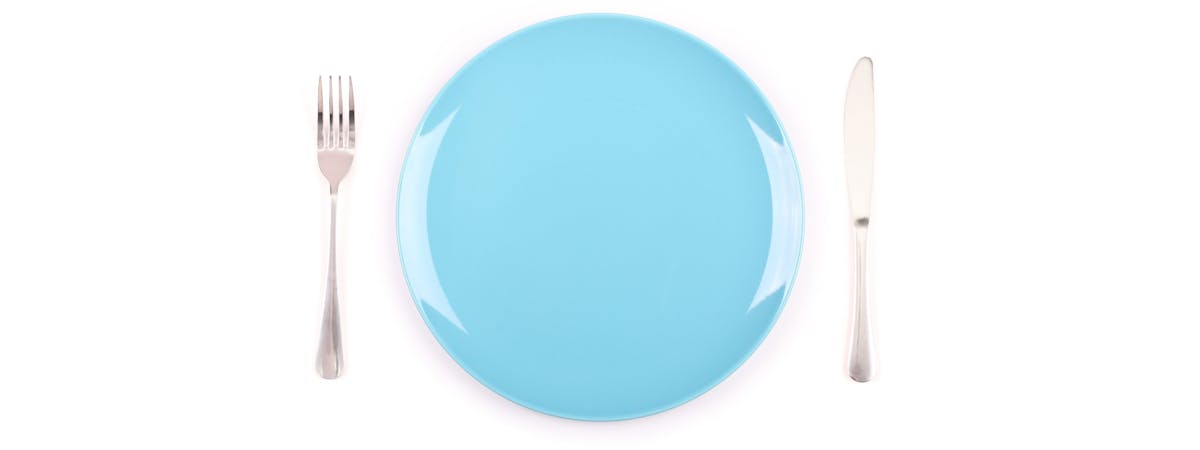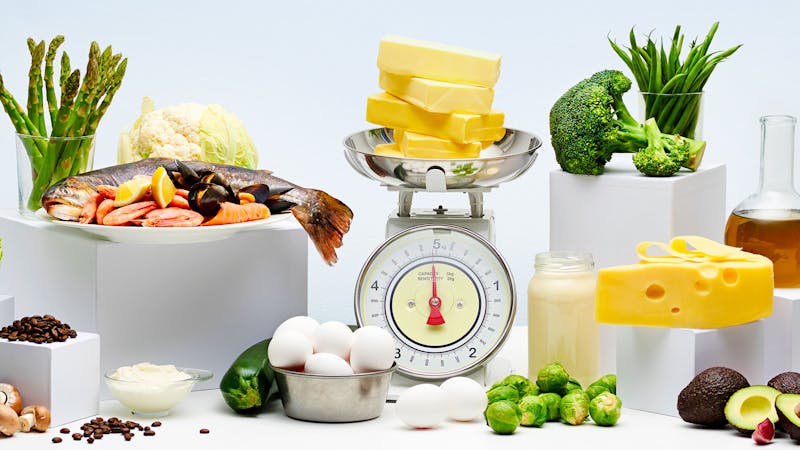How to treat insulin resistance
Insulin resistance is a common, almost silent condition in which the body’s cells become less able to efficiently respond to the hormone insulin.1 This causes the pancreas to secrete even more insulin to keep blood sugar from rising too high.
As described in our in-depth companion guide: What you need to know about insulin resistance, this becomes a vicious cycle with insulin rising higher and higher and cells becoming even more resistant.2
Eventually this may lead to pre-diabetes, type 2 diabetes, PCOS, or other chronic health conditions.
For more information about how and why insulin resistance happens, the health conditions related to insulin resistance, and how insulin resistance is diagnosed please refer to our companion guide.

What you need to know about insulin resistance
GuideInsulin is an essential hormone we can’t live without. What happens, however, when it is chronically too high? Our tissues stop responding to it effectively. That’s insulin resistance.
Can drugs help?
If you have been diagnosed with insulin resistance, your first question may be whether any medications can treat this condition. While the FDA has not approved any drugs specifically to treat insulin resistance, there are two commonly prescribed drugs for diabetes that can improve insulin sensitivity.
Many doctors prescribe metformin for patients with prediabetes and/or insulin resistance. It works by decreasing glucose production by the liver and increasing the insulin sensitivity of cells.3 However, it does not address the underlying cause of the insulin resistance.
Pioglitazone is another medication that lowers blood sugar by enhancing the body’s sensitivity to insulin.4 This drug tends to not be as popular as metformin, however, in part due to the potential side effect of mild weight gain.
Though drugs may play a role in improving insulin sensitivity and delaying the onset of type 2 diabetes, they are rarely adequate as a sole intervention. What else can you do if you have insulin resistance? This guide explores the lifestyle changes you can make as supported by the latest evidence.

The low carb diet
Practically any dietary intervention that results in weight loss, especially fat loss within the abdomen, can temporarily improve insulin sensitivity.5 A low carb diet certainly fits this description, and may be more effective than low fat diets for improving insulin sensitivity.6 One weak observational study even suggested improved survival for those with prediabetes who ate a lower carbohydrate diet, while a stronger nonrandomized trial reported glucose normalization in over 50% of participants with prediabetes.7
The reason why low carb diets are good for people with insulin resistance is simple: if you are not eating sugar — or carbohydrates that rapidly digest to sugar — you will have less sugar entering your bloodstream and therefore less of a need to make insulin to move sugar (glucose) out of the blood and into cells.
If your body is already resistant to insulin, creating this internal environment in which high levels of insulin are not needed to maintain normal blood sugars is extremely helpful.
Studies show that a low carb diet can be an effective diet for improving blood sugar control and achieving type 2 diabetes remission.8 Since insulin resistance plays a major role in causing type 2 diabetes, a low carb diet is likely also good for addressing pre-existing insulin resistance before full-blown type 2 diabetes develops.
One short study in 2005 showed a 75% improvement in insulin sensitivity in ten patients with obesity and type 2 diabetes who went on a low carb diet.9
In two other studies, a very low carbohydrate diet was better at lowering insulin levels than a low fat diet.10 Of note, both groups in the latter study demonstrated equal weight loss, suggesting that it was the composition of the diet — not the weight loss alone — that was the most effective intervention to bring insulin levels down.
Yet another trial showed that a low carb diet was better than a low fat diet plus a popular prescription weight loss drug for lowering insulin, glucose and HbA1c levels.11 Again, both groups lost the same amount of weight, but the diet with the lower carbohydrate levels achieved better results in blood sugar control and insulin levels.
Finally, one study reports that people with insulin resistance have worse compliance with a low fat diet, and better compliance with a low carb diet.12
Takeaway: Reducing your intake of sugar and carbs that digest to sugar will likely result in reduced insulin production and improved insulin resistance.
What does this diet look like? Dozens of guides on our site delve into all aspects of low carb and ketogenic eating. Check out these two to start:
Other dietary evidence
It is important to note that studies also show that any diet that causes weight loss can reduce insulin resistance and improve insulin sensitivity — at least for a time.13
The reverse is true, too. Any diet that causes a rapid increase in bodyweight, such as from consuming high carb, high fat, high calorie foods (sometimes called over-nutrition), can immediately cause insulin resistance — within days — even among healthy young men.14
Over the years, other areas of research have explored the possibility of specific diets decreasing insulin resistance:
- increasing protein intake15
- increasing dietary fiber intake16
- eating low-glycemic index foods17
- lowering dietary fat intake18
To learn more about the strengths and weakness of these other dietary approaches, and why we recommend low carb eating, click below:
Takeaway: A diet that is low in carbs, higher in protein, and high in soluble fiber from above-ground vegetables appears to have the best current evidence for reducing insulin resistance.
Intermittent fasting/time-restricted eating
Intermittent fasting is a popular dietary trend that entails exactly what it sounds like: not eating during certain time periods. Though it may seem like a fad to some, studies suggest intermittent fasting can improve insulin sensitivity.19
Although not all studies agree. For instance, one RCT that did not control for how much or what the subjects ate, didn’t demonstrate a benefit in insulin sensitivity for those doing 16:8 time-restricted eating.20 One lesson to draw from this is that what you eat and how much you eat is just as or likely even more important than when you eat.
There are multiple mechanisms by which fasting may improve insulin sensitivity. Cells can increase the number of insulin receptors on their surface, and those receptors can demonstrate an increased affinity for binding insulin during fasting.21
Also, various hormone levels increase during fasting and are thought to increase insulin sensitivity.22 For example, adiponectin – a fat-cell specific hormone – appears to enhance insulin sensitivity through increased fatty acid oxidation and inhibition of glucose production by the liver.23
When it comes to implementing intermittent fasting, time-restricted eating is one type of fasting that involves eating meals within a set time-frame each day, such as between 11 am and 7 pm. A review of studies in healthy subjects showed that eating fewer meals during a shorter feeding window resulted in better glucose and insulin levels.24
Another type of IF is alternate day fasting. Healthy males who fasted for 20 hours every other day for 15 days showed greater glucose uptake with the same insulin levels, in essence improving their insulin sensitivity.25
Another trial reported greater improvements in insulin resistance among women using intermittent caloric restriction (fasting) compared to chronic caloric restriction.26
Based on the fact that both fasting and low carb diets have been shown to improve insulin sensitivity, we hypothesize that the combination of a low carb diet with periodic intermittent fasting is likely the most effective nutritional intervention for treating insulin resistance and hyperinsulinemia.
Intermittent fasting may seem daunting, but if you are interested in exploring it, check out our guide:

Intermittent fasting for beginners
Guide Intermittent fasting can help you lose weight, increase energy and gain several health benefits. You can also save lots of time and money. There are, however, many questions about how to do IF in a safe and effective way. In this guide by Dr. Jason Fung, a top fasting expert, you’ll quickly learn how to do it.
Physical activity and exercise
Muscles burn glucose for energy. The more you move, the more glucose your muscles take out of the blood for energy use, which helps to lower your blood sugar levels. This allows for a reduction in insulin secretion, lessening the burden on your pancreas.
Likewise, muscles that don’t move don’t need to use much glucose, leading to a rise in insulin levels to process the excess blood sugar. Studies show that a mere five days of bed rest induces a state of insulin resistance in completely healthy volunteers.27 Multiple studies show that long-term inactivity is strongly associated with insulin resistance, metabolic syndrome and pre-diabetes.28
Any type of regular movement can help. Studies suggest that high-intensity interval training (HIIT), resistance training, and cardio training all improve glucose utilization and thereby improve insulin sensitivity.29
No matter what your preferred form of movement or exercise, it is clear: inactivity can lead to insulin resistance. And movement increases insulin sensitivity as long as the exercise continues.30 So if you stop moving regularly, insulin resistance may come back. (Move it or lose it!)
One more thing on exercise: you likely cannot outrun a bad diet. Exercising regularly but still eating a high carbohydrate, high-sugar diet will likely partially, if not completely, counteract many of the benefits derived from exercise.31
Based on the evidence, it appears that the combination of regular exercise and a well formulated low carb diet is an effective approach for treating insulin resistance and hyperinsulinemia.
Sleep
Studies show that short-term sleep deprivation raises glucose levels and worsens insulin resistance.32 A chronic sleep disturbance, such as from obstructive sleep apnea, is also associated with worsening insulin resistance.33
It’s unclear how much sleep is too little, just enough, or too much. Is there a difference in insulin sensitivity in someone who gets six hours of sleep per night instead of eight? Is there a certain amount of lost sleep, or a frequency of bad nights that triggers insulin resistance? We don’t know.
However, it is clear that there is an association between insulin resistance and sleep. And treating sleep problems may result in improved insulin sensitivity.34
Stress
Studies show temporary insulin resistance arises during periods of short term physiological and psychological stress, such as a sudden illness or sudden threat.35 In theory, this could have been an evolutionary advantage at some point in human existence and has been termed “adaptive insulin resistance”.36 It makes sense that you would want to mobilize stored energy during infection, trauma, or stress, so inhibition of insulin (which stores energy) would be a good thing. This type of insulin resistance reverses when the sudden stress is over. Such a response to short-term stress likely has no long-term negative consequences.
However, it appears that chronic stress and chronic activation of the body’s fight or flight response will also lead to insulin resistance.37 Since this chronic stress is longer-term, without a sudden onset or quick resolution of the trigger, it may lead to longer-term negative consequences.
Two small controlled studies demonstrated that meditation alone helped reduce blood sugar in patients with heart disease.38 Since mindfulness training, yoga, meditation, dancing, singing, and walking in nature can be effective ways to reduce stress, increase wellbeing and improve overall physical health, they may also help with insulin resistance.
Explore the ways that you relax best, and you may be helping improve your insulin sensitivity.
Tobacco use
No aspect of smoking is good for health, but some studies report that active smoking is associated with insulin resistance and the development of diabetes.39
Can we cure insulin resistance?
Once someone has dramatically improved their insulin resistance, bringing insulin and blood sugar levels down by eating a low carb diet, and they have improved their exercise, stress management, and sleep, the question then becomes: are they cured?
Probably not. The word cure implies that the person can go back to eating however they want and the insulin resistance will not return. Unfortunately, that’s not how it works. The vast majority of people who reverse their insulin resistance, lower their chronically high insulin levels, and lower their blood sugars will see those all return to previous high levels if they stop their lifestyle interventions and return to their old diets and habits.40
This reinforces the need to make lifestyle changes that can be maintained for decades and lifetimes. Crash diets or short-term interventions only help in the moment. Insulin sensitivity is a lifelong balance.
However, some people may have what amounts to a partial cure, especially if their insulin resistance is caught early. Clinical practice suggests that for some people, eating a low carb diet, losing weight and getting insulin levels down will restore insulin sensitivity and may allow them to regain the degree of metabolic flexibility found in healthy individuals.41
That metabolic flexibility may allow them to increase the amount of carbs they can safely eat from 20 grams per day up to 75 grams, or it may allow them to reduce the amount of exercise they need to keep blood sugar and insulin levels low.42
In addition to maintaining weight loss, regular blood tests may be required to determine who will achieve metabolic flexibility and how much flexibility they can “get away with” without triggering the cycle of insulin resistance again.
So the best advice may be to stick with the most intensive lifestyle change you can maintain and be vigilant about screening for recurrence of insulin resistance. This starts with keeping an eye on your waist size, but also may include regular (every 6 months or so) blood tests for fasting insulin and fasting glucose.
See our companion guide What you need to know about insulin resistance, which discusses diagnostic tests.
You can also measure your 2-hour post-meal blood sugar levels after a low carb meal and a moderate-carb meal and compare the readings. If a moderate carb meal causes your blood sugar to go over 140 mg/dl (7.8 mmol/L), that could be a sign that you may still be insulin resistant.43 Note that this is our expert opinion, and not based on hard data.

What you need to know about blood sugar
Guide If you have a diagnosis of diabetes, you’ve probably been tracking your blood sugar for years. But if you’ve recently decided to try a low carb or ketogenic diet, you may need to understand your results in the context of your new dietary pattern.
Summary
Insulin and its proper functioning are important for survival and good long-term health. Obesity, metabolic dysfunction, and chronically high insulin levels make your body less responsive to this essential hormone, which might increase your risk of developing serious chronic health conditions.44
Adopting effective lifestyle changes — like a low carb diet, regular physical activity, and a good sleep routine — can lower insulin levels and reduce insulin resistance.
Did you enjoy this guide?
We hope so. We want to take this opportunity to mention that Diet Doctor takes no money from ads, industry or product sales. Our revenues come solely from members who want to support our purpose of empowering people everywhere to dramatically improve their health.
Will you consider joining us as a member as we pursue our mission to make low carb simple?
How to treat insulin resistance - the evidence
This guide is written by Dr. Bret Scher, MD and was last updated on February 6, 2023. It was medically reviewed by Dr. Michael Tamber, MD on March 16, 2022.
The guide contains scientific references. You can find these in the notes throughout the text, and click the links to read the peer-reviewed scientific papers. When appropriate we include a grading of the strength of the evidence, with a link to our policy on this. Our evidence-based guides are updated at least once per year to reflect and reference the latest science on the topic.
All our evidence-based health guides are written or reviewed by medical doctors who are experts on the topic. To stay unbiased we show no ads, sell no physical products, and take no money from the industry. We're fully funded by the people, via an optional membership. Most information at Diet Doctor is free forever.
Read more about our policies and work with evidence-based guides, nutritional controversies, our editorial team, and our medical review board.
Should you find any inaccuracy in this guide, please email andreas@dietdoctor.com.
The Clinical Biochemist Reviews 2005: Insulin and insulin resistance
[overview article; ungraded] ↩Diabetes Care 2008: Insulin resistance and hyperinsulinemia [overview article; ungraded] ↩
Diabetes & Metabolism 2003: Reducing insulin resistance with metformin: the evidence today [review article; ungraded] ↩
Current Diabetes Report 2019: Thiazolidinediones: the Forgotten Diabetes Medications[overview article; ungraded] ↩
Nutrition & Diabetes 2017: Enhanced insulin sensitivity in successful, long-term weight loss maintainers compared with matched controls with no weight loss history [case control study; weak evidence] ↩
Journal of the American College of Nutrition 2013: Improvements in glucose metabolism and insulin sensitivity with a low carbohydrate diet in obese patients with type 2 diabetes [uncontrolled study; weak evidence]
JCI Insight 2019: Dietary Carbohydrate Restriction Improves Metabolic Syndrome Independent of Weight Loss [randomized trial; moderate evidence]
Obesity 2015: Weight loss on low fat vs. low carb diets by insulin resistance status among overweight adults & adults with obesity: A randomized pilot trial [moderate evidence]
↩Clinical Nutrition 2020:
Associations of low carbohydrate and low fat intakes with all-cause mortality in subjects with prediabetes with and without insulin resistance [nutritional epidemiology study, very weak evidence]Nutrients 2021: Type 2 Diabetes Prevention Focused on Normalization of Glycemia: A Two-Year Pilot Study [nonrandomized study, weak evidence]
↩European Journal of Clinical Nutrition 2017: The interpretation and effect of a low carbohydrate diet in the management of type 2 diabetes: a systematic review and meta-analysis of randomised controlled trials [strong evidence]
Diabetes Therapy 2018: Effectiveness and safety of a novel care model for the management of type 2 diabetes at 1 year: an open-label, non-randomized, controlled study [weak evidence]
PLoS One 2020: Effect of a 90 g/day low carbohydrate diet on glycaemic control, small, dense low-density lipoprotein and carotid intima-media thickness in type 2 diabetic patients: An 18-month randomised controlled trial[randomized trial; moderate evidence]
↩Annals of Internal Medicine 2005: Effect of a low carbohydrate diet on appetite, blood glucose levels, and insulin resistance in obese patients with type 2 diabetes [uncontrolled study; weak evidence] ↩
Lipids 2009: Carbohydrate restriction has a more favorable impact on the metabolic syndrome than a low fat diet [randomized trial; moderate evidence]
Nutrition & Metabolism 2006: Comparison of isocaloric very low carbohydrate/high saturated fat and high carbohydrate/low saturated fat diets on body composition and cardiovascular risk [randomized trial; moderate evidence]
↩Journal of the American Medical Association 2010: A randomized trial of a low carbohydrate diet vs orlistat plus a low fat diet for weight loss [moderate evidence] ↩
Diabetes, Obesity, and Metabolism 2013: Adherence to a low fat vs. low carbohydrate diet differs by insulin resistance status[randomized trial; moderate evidence] ↩
- Nutrition & Diabetes 2017: Enhanced insulin sensitivity in successful, long-term weight loss maintainers compared with matched controls with no weight loss history [case-controlled series; weak evidence]
- JAMA Natwork Open 2020: Effect of a Low Fat Vegan Diet on Body Weight, Insulin Sensitivity, Postprandial Metabolism, and Intramyocellular and Hepatocellular Lipid Levels in Overweight Adults: A Randomized Clinical Trial[randomized trial; moderate evidence]
- Nutrients 2018: A Plant-Based High Carbohydrate, Low Fat Diet in Overweight Individuals in a 16-Week Randomized Clinical Trial: The Role of Carbohydrates[randomized trial; moderate evidence]
- African Health Sciences 2018: Impact of weight reduction on insulin resistance, adhesive molecules and adipokines dysregulation among obese type 2 diabetic patients[randomized trial; moderate evidence]
- British Journal of Nutrition 2013: The effect of intermittent energy and carbohydrate restriction v. daily energy restriction on weight loss and metabolic disease risk markers in overweight women[randomized trial; moderate evidence]
Science of Translational Medicine 2015: Excessive caloric intake acutely causes oxidative stress, GLUT4 carbonylation, and insulin resistance in healthy men [uncontrolled intervention trial; weak evidence] ↩
Higher protein diets consistently demonstrate improved glucose control, including helping achieve diabetes remission. This RCT reported those following a diet with 27% protein compared to 16% had better preservation of lean mass and a better glycemic response despite no difference in weight loss.
Nutrients 2018: Effects of Adherence to a Higher Protein Diet on Weight Loss, Markers of Health, and Functional Capacity in Older Women Participating in a Resistance-Based Exercise Program
[randomized trial; moderate evidence]This randomized crossover study reported subjects with type 2 diabetes had a greater reduction in A1c and total daily glucose, fatty liver, and fatty pancreas with a 30% carb/30% protein diet compared to a 50% carb/17% protein diet.
Diabetologia 2019:
A carbohydrate-reduced high protein diet improves HbA1c and liver fat content in weight stable participants with type 2 diabetes: a randomised controlled trial[randomized trial; moderate evidence]This small RCT reported 100% prediabetes remission with a higher protein diet.
Nutrition, Metabolism, and Cardiovascular Diseases 2020: High protein diet leads to prediabetes remission and positive changes in incretins and cardiovascular risk factors
[randomized trial; moderate evidence] ↩Diabetes Care 2006: Cereal fiber improves whole-body insulin sensitivity in overweight and obese women [randomized trial; moderate evidence]
Metabolism 2018: A whole-grain diet reduces peripheral insulin resistance and improves glucose kinetics in obese adults: A randomized-controlled trial[moderate evidence] ↩
The data on this are surprisingly mixed as we describe further in our “learn more” section.
Nutrients 2018: The effect of dietary glycaemic index on glycaemia in patients with type 2 diabetes: A systematic review and meta-analysis of randomized controlled trials [strong evidence] ↩
Studies such as the following highlight data that saturated fat intake is associated with insulin resistance. However, as we show in our “learn more” section, this might be inaccurate in the context of a low carb diet.
Diabetes care 2020: Intrahepatic Fat and Postprandial Glycemia Increase After Consumption of a Diet Enriched in Saturated Fat Compared With Free Sugars[randomized trial; moderate evidence]
Nutrients 2019: Fat Quantity and Quality, as Part of a Low Fat, Vegan Diet, Are Associated with Changes in Body Composition, Insulin Resistance, and Insulin Secretion. A 16-Week Randomized Controlled Trial[randomized trial; moderate evidence]
Clinical Nutrition 2004: Dietary fat, insulin sensitivity and the metabolic syndrome [review article; ungraded] ↩
Nutrition Review 2014: Time-restricted feeding and risk of metabolic disease: a review of human and animal studies [overview article; ungraded] ↩
16:8 refers to fasting for 16 hours and eating all food for the day within an 8-hour window.
JAMA Internal Medicine 2020: Effects of Time-Restricted Eating on Weight Loss and Other Metabolic Parameters in Women and Men With Overweight and Obesity: The TREAT Randomized Clinical Trial[randomized trial; moderate evidence] ↩
Journal of Clinical Investigation 1976: Fluctuations in the affinity and concentration of insulin receptors on circulating monocytes of obese patients: effects of starvation, refeeding, and dieting[uncontrolled intervention trial; weak evidence] ↩
Journal of Applied Physiology 2005: Effect of intermittent fasting and refeeding on insulin action in healthy men[non-randomized trial; weak evidence] ↩
Obesity Reviews 2005: Adiponectin: action, regulation and association to insulin sensitivity[overview article; ungraded] ↩
Nutrition Review 2014: Time-restricted feeding and risk of metabolic disease: a review of human and animal studies [overview article; ungraded] ↩
Journal of Applied Physiology 2005: Effect of intermittent fasting and refeeding on insulin action in healthy men [uncontrolled intervention trial; weak evidence] ↩
International Journal of Obesity 2011: The effects of intermittent or continuous energy restriction on weight loss and metabolic disease risk markers: a randomized trial in young overweight women [moderate evidence] ↩
Arteriosclerosis, Thrombosis and Vascular Biology 2007: Physical inactivity rapidly induces insulin resistance and microvascular dysfunction in healthy volunteers [uncontrolled intervention study; weak evidence] ↩
Medicine and Sport Science 2014: Sedentary behavior as a mediator of type 2 diabetes [overview article; ungraded] ↩
British Medical Journal Open Sport Exercise Medicine 2016: Update on the effects of physical activity on insulin sensitivity in humans [overview article; ungraded] ↩
Journal of Obesity and Weight Loss 2015: Exercise training and insulin resistance: A current review [overview article; ungraded] ↩
The following study showed that exercise alone led to minimal weight loss, whereas diet alone had a much greater effect:
Obesity 2012: Effect of diet and exercise, alone or combined, on weight and body composition in overweight-to-obese post-menopausal women [randomized trial; moderate evidence]
And this study shows that, as exercise increases beyond a certain threshold, total energy expenditure will actually decrease, suggesting that the body will down-regulate resting metabolic rate if exercise is long or intense:
Current Biology 2016: Constrained Total Energy Expenditure and Metabolic Adaptation to Physical Activity in Adult Humans [non-randomized trial; weak evidence]
↩- Lancet 1999: Impact of sleep debt on metabolic and endocrine function [non-randomized study; weak evidence]
- Healthcare (Basel) 2019: The interlinked rising epidemic of insufficient sleep and diabetes mellitus [overview article; ungraded]
Clinical Endocrinology 2003: Obstructive sleep apnoea syndrome impairs insulin sensitivity independently of anthropometric variables [non-randomized study; weak evidence] ↩
European Respiratory Journal 2010: A randomised controlled trial of nasal continuous positive airway pressure on insulin sensitivity in obstructive sleep apnoea [moderate evidence] ↩
Journal of Endocrinology 2013: Acute psychological stress results in the rapid development of insulin resistance [mouse study; very weak evidence] ↩
The following paper hypothesizes that insulin resistance played a role in evolution and may have been a natural adaptation to illness, injury or temporary starvation.
Metabolism 2013: Insulin resistance: An adaptive mechanism becomes maladaptive in the current environment — An evolutionary perspective [overview article; ungraded] ↩
- Psychoneuroendocrinology 2005: Role of stress in the pathogenesis of the metabolic syndrome [overview article; ungraded]
- Journal of Epidemiology 2016: Investigation of the relationship between chronic stress and insulin resistance in a Chinese population [cross-sectional observational study; very weak evidence]
While the change in insulin levels among meditators from the beginning to end of the studies was not statistically significant, meditators had significantly lower insulin levels than control subjects by the end of each study.
International Journal of Yoga 2018: Effect of 6 months of meditation on blood sugar, glycosylated hemoglobin, and insulin levels in patients of coronary artery disease [randomized trial; moderate evidence]
Archives of Internal Medicine 2006: Effects of a randomized controlled trial of transcendental meditation on components of the metabolic syndrome in subjects with coronary heart disease [moderate evidence]
↩- Annales de Cardiologie et d’Angéiologie 2016: Effect of cigarette smoking on insulin resistance risk [observational study; very weak evidence]
- Journal of the American Medical Association 2007: Active smoking and the risk of type 2 diabetes: a systematic review and meta-analysis [moderate evidence]
But not all studies have found a link between tobacco and insulin resistance:
PLoS One 2016: Tobacco use, insulin resistance, and risk of type 2 diabetes: Results from the multi-ethnic study of atherosclerosis [prospective cohort study; weak evidence]
Nonetheless, it is clear that quitting smoking is critical for improving health on many different levels, which may include improving insulin sensitivity.
↩This is based on clinical experience of low carb practitioners and was unanimously agreed upon by our low carb expert panel. You can learn more about our panel here [weak evidence]. ↩
This is based on consistent clinical experience. [weak evidence] ↩
This is based on consistent clinical experience. [weak evidence] ↩
International Journal of Cancer 2017: Association between hyperinsulinemia and increased risk of cancer death in nonobese and obese people: A population‐based observational study [observational study with HR < 2; very weak evidence]
The New England Journal of Medicine 1996: Hyperinsulinemia as an independent risk factor for ischemic heart disease [observational study with HR < 2; very weak evidence] ↩





